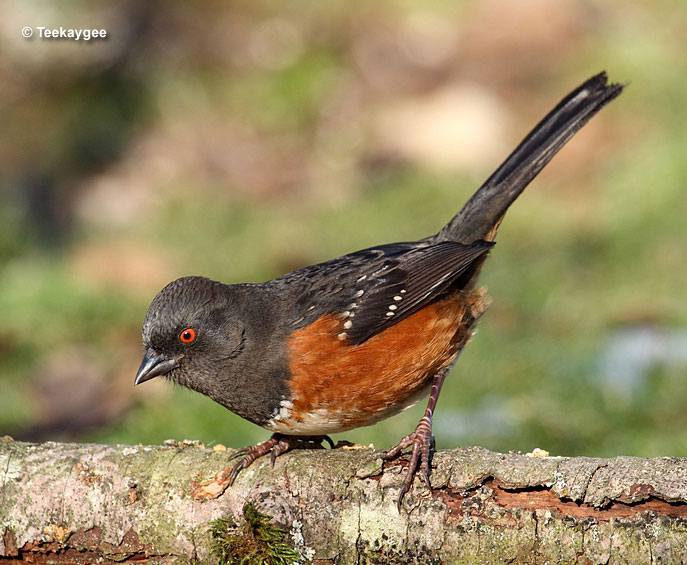Eastern Towhee (Pipilo erythrophthalmus) is a striking and distinctive bird species native to the eastern United States.
With their bold black and rust-colored plumage and unmistakable “drink-your-tea” call, they are a common sight and sound in shrubby habitats across their range.
These birds are known for their secretive behavior, often hiding in the underbrush and using their strong legs to scratch through leaf litter in search of food.
On this page
Identification
Eastern Towhees look like large sparrows. They have a chunky body, thick, triangular, and pointed bills, and long rounded tails. These birds generally have dark red eyes. However, individuals in Florida and along the southern Atlantic coast have pale, almost white eyes.
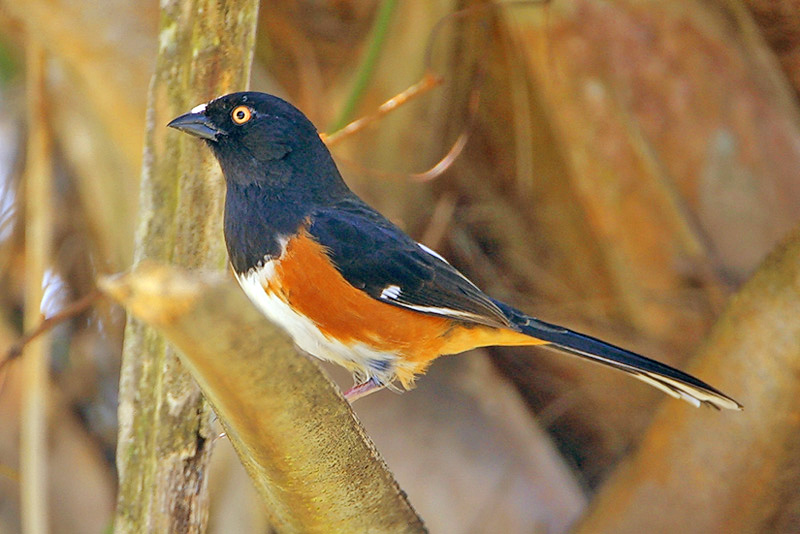
Male Eastern Towhee. Photograph © Greg Lavaty.
Male Eastern Towhees have black upperparts, a black head, and a black throat. Their bellies are white and their sides and the undersides of their wings are rust-colored. Males’ wings and tails are black with white marks along the edges.
Female Eastern Towhees have a similar plumage pattern. Their bellies are white, sides rufous, and wings and tails have white marks. However, their head, throat, back, wings, and tail are dull brown instead of black.
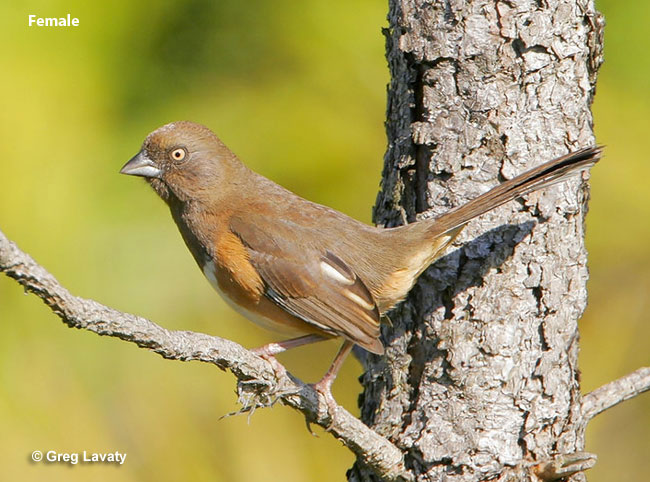
Female Eastern Towhee
Overall, juvenile Eastern Towhees can be described as brown with a pale underside and heavy streaking. Juvenile males have black wings and tails, and blotches of black on their backs. Juvenile females are lighter and colored in light browns.
You can also identify Eastern Towhees by their behavior. Outside of the breeding season, they are solitary, mostly foraging on the ground, scratching around in leaves, and doing little backward hops. They like to preen and stretch on perches between bouts of singing.
Eastern Towhees have a variety of sounds, both songs and calls they use to communicate with each other. Males’ song lasts about a second and typically consists of three whistle-notes, the first and the last being about the same pitch and the middle one lower pitched. The final note is trilled. Their most common calls are rising two-parted tow-hee, joree, or chewink calls.
Food
Eastern Towhee’s diet consists of insects, other invertebrates, leaves, seeds, small fruits, berries, grains, and nuts. The animal part of their diet consists of spiders, millipedes, snails, centipedes, caterpillars, beetles, moths, ants, and butterflies, and very rarely includes small lizards and snakes.
Their preferred plant foods include blackberries, blueberries, smartweeds, grasses, wheat, corn, soft leaves, and flower buds.
For the majority of the time, they forage on the ground in densely covered areas, scratching at leaves by kicking both feet back at the same time, which looks like a little backward hop.
This disturbs the hiding insects and forces them to move, making them an easy snack for the birds. You can also see them foraging in shrubs and low trees, gleaning from branches, trunks, and foliage.
Nesting and Eggs
Towhees are monogamous throughout the breeding season. The male begins courtship by singing, chasing a female, and displaying. During this commotion, females are passive, only answering with songs of their own. Paired birds become inseparable.
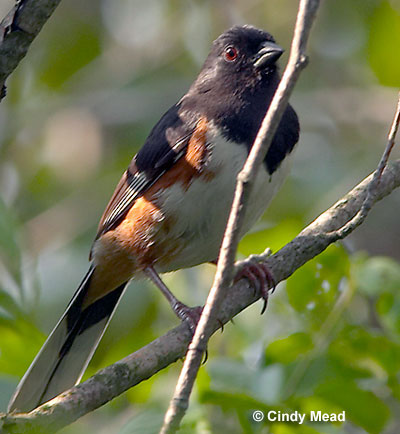
Eastern Towhees nest on the ground under a shrub, occasionally in bushes up to 4 feet above the ground. The female gathers the nest materials and builds the nest herself, with the male following along but not helping.
The completed product is four inches in diameter and consists of small twigs, bark strips, leaves, weeds, rootlets, and grasses, and is lined with finer materials, including fine plant material and animal hair.
Eastern Towhees can have up to three broods in a year, depending on the location and length of the breeding season.
The female lays 2-6 eggs in a clutch that are about an inch long and 0.7-0.8 inches wide. Eastern Towhee eggs can be creamy white to pale gray or even greenish white and are spotted with darker colors.
The mother bird incubates the eggs for 12-13 days, during which they only leave the nest to forage. Males may bring food close to the nest and guard the female if she goes out to find food.
Young leave the nest 10-12 days after hatching and reach independence after about a month. Both parents feed and take care of them before that.
Current Situation
Eastern Towhees range throughout the eastern part of the United States. Their breeding range covers the northern half, and their year-round range covers the southeastern part of that area. Birds north of southern Indiana and Virginia migrate southward as far as southern Texas for the winter.
Eastern Towhees inhabit overgrown open woodlands and fields, forest edges, scrubby backyards, and thickets. Habitat varies from region to region, but they can always be found in brushy areas with plenty of leaves to rummage around in.
Eastern Towhees are listed as of least concern on the IUCN Red List. However, their population is in decline which is attributed to people constructing farms and houses, destroying and altering their natural habitats.
Facts
- Eastern Towhee and Spotted Towhee look very similar and can produce hybrids. Previously, all of them were considered to be a single species called the Rufous-sided Towhee. Now they’re recognized as separate species.
- Towhees have a distinct call that can be described with the phrase drink-your-tea. This is probably why a group of towhees is called a teapot (or a tangle).
- If you want to attract Eastern Towhees to your yard, leave some parts of your yard unkempt and shrubby. They like to rummage around in leaves and vegetation near overgrown shrubs and bushes. You may also put up feeders with millet, oats, milo, and cracked corn, although they might prefer to pick up seeds from the ground.
- Eastern Towhees have developed multiple strategies to evade and chase away predators. If a towhee is alone while foraging and senses a predator nearby, it will remain motionless in the hope that the predator moves on. Males warn each other by giving alarm calls and then mob the predator. Females try to lure predators away from the nest by acting as if they’re injured.
- In the wild, Eastern Towhees live for around 1-6 years. The oldest known wild specimen lived to be 12 years old.
Similar Species
These birds are quite unique in their appearance. We have introduced two similar species and how to know which bird you’re dealing with.
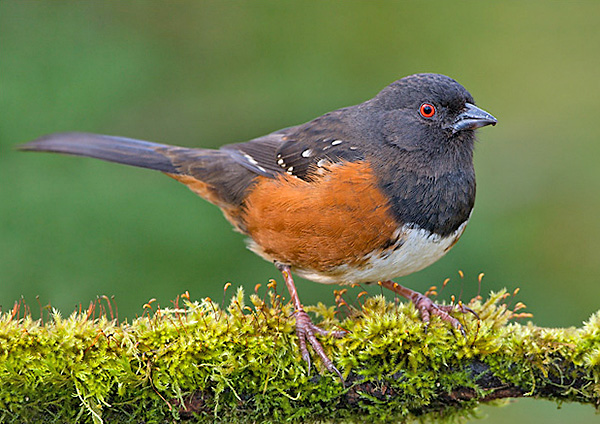
Spotted Towhee. Photograph © Glenn Bartley.
Eastern Towhees and Spotted Towhees are almost identical, but their range has almost no overlap with the Eastern Towhees inhabiting eastern North America and Spotted Towhees in western North America.
Adult male Eastern Towhees have white patches on their wings, whereas male Spotted Towhees have white spots. Females have more differences, including the white markings on their wings.
Female Eastern Towhees have a brown upperside, head, and throat, whereas female Spotted Towhees have a dull dark gray upperside, head, and throat.
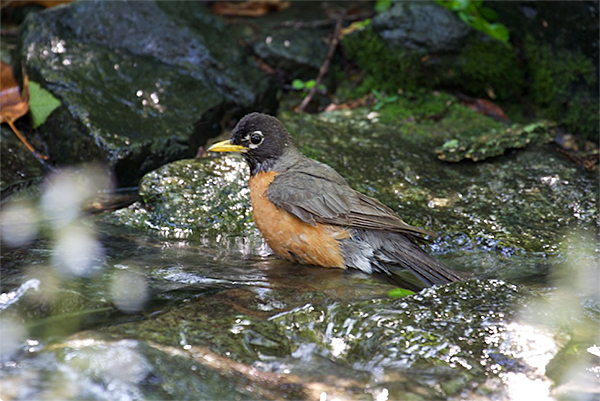
American Robin. Photo by Neil Soderstrom.
When it comes to comparing the two, American Robins have thinner and yellow bills, whereas Eastern Towhees have thick and conical blackish bills.
Robins are also larger, have white only on the very lower part of their bellies, and have white rings around their eyes.
Frequently Asked Questions
Is the Eastern Towhee rare?
Eastern Towhees are fairly common within their range, and they’re listed as a species of least concern on the IUCN Red List. However, their numbers have been in decline.
What is the difference between an Eastern Towhee and a Rufous-sided Towhee?
The Rufous-sided Towhee previously included both the Eastern Towhee and Spotted Towhee. Now they’re considered as separate species.
Why is it called a towhee?
Towhees are named after their most common and distinctive call, which is a rising call that sounds like tow-hee, joree, or chewink.
Do Eastern Towhees mate for life?
The otherwise solitary Eastern Towhees form monogamous pair bonds for the breeding season. It is unknown whether they mate for life.
Do towhees use birdhouses?
Towhees nest on the ground and will not accept nor use birdhouses.

